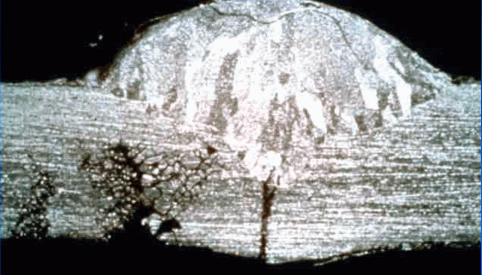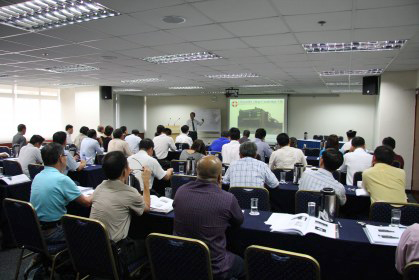|
 |
|
Home |
Consulting |
Training |
Expert Witness |
Failure Analysis |
Design Review |
Corrosion Test |
Corrosion Software |
Protective Coatings |
Materials Selection |
Cathodic Protection |
>>> |
|
Preferential Weld Corrosion: Causes and Prevention |
|
Course Outline |Who Should Attend |Registration |In-House |On-Demand |Online Courses |PPT Slides+Testbank |Course List
|
Why WebCorr
|
|
Course Overview |
|
 Welding
plays an essential role in the fabrication of components and structures
such as reactor vessels, pipe work, heat exchangers etc. The associated
local heating and cooling can significantly affect the corrosion
resistance of the material. A welded joint constitutes a significant
discontinuity in a structure from the compositional, metallurgical, and
mechanical viewpoints. In many situations it is the performance of
welded joints that determines the useful service life of the component
or structure. This 3-day advanced course covers the causes of different
forms of preferential weld corrosion and the practical methods of
prevention. Welding
plays an essential role in the fabrication of components and structures
such as reactor vessels, pipe work, heat exchangers etc. The associated
local heating and cooling can significantly affect the corrosion
resistance of the material. A welded joint constitutes a significant
discontinuity in a structure from the compositional, metallurgical, and
mechanical viewpoints. In many situations it is the performance of
welded joints that determines the useful service life of the component
or structure. This 3-day advanced course covers the causes of different
forms of preferential weld corrosion and the practical methods of
prevention.
This corrosion short course is
available for in-house training, online and distance learning worldwide.
It can also be customized to meet the specific needs of your
organization.
|
|
|
|
Course Outline |
|
|
|
1. Introduction to Corrosion
2. Overview of Preferential Weld Corrosion
3. Weldment Metallurgy and Preferential Weld Corrosion
3.1 Effect of Welding on Corrosion
3.1.1 Factors affecting weldment corrosion
3.1.2 Methods of welding
3.1.3 Welding austenitic SS vs carbon steel
3.1.4 Residual stress and stress concentration
3.1.5 Weld defects
3.1.6 Weld metallurgy
3.1.7 Weld metal composition
3.1.8 Iron contamination: its effects & removal
3.1.9 Heat tint: its effects & removal
3.1.10 Summary of fabrication defects
3.2 Precipitation of intermetallics (sigma, chi & Laves phases)
in stainless steels
3.2.1 Microstructural features in SS
3.2.2 Precipitation of delta ferrite and Schaeffler Diagram
3.2.3 Alpha prime phase and 475°C embrittlement
3.2.4 Precipitation of intermetallics:
submicroscopic sigma, chi and Laves phases
3.2.5 Chemical compositions of various intermetallics and phases
3.2.6 Time-Temperature-Precipitation diagrams for
sigma, chi and Laves phases and carbides
3.2.7 Effect of chemical composition on sigma precipitation
3.2.8 Effect of Nitrogen on sigma precipitation
3.2.9 Effect of cold working on sigma precipitation
3.2.10 Invisible (submicroscopic) sigma/chi phases and their effects on corrosion
3.2.11 Time-temperature-precipitation curves for various austenitic stainless
steels: precipitation of carbides, sigma, chi and Laves phases
3.3 Intergranular corrosion, weld decay and knifeline attack
3.3.1 Sensitization of austenitic stainless steels
3.3.2 Cr profile along the grain boundaries
3.3.3 Effect of carbon, molybdenum and nitrogen on
time-temperature- precipitation diagrams
3.3.4 Effect of cold working and applied stress
3.3.5 Sensitization of Ferritic Stainless Steels
3.3.6 Sensitization of Duplex Stainless Steels
3.3.7 Effect sulfide inclusions in stainless steels
3.3.8 Ferritic and duplex stainless steels
3.3.9 Nickel-chromium alloys
3.3.10 Aluminum alloys
3.3.11 Weld decay and knifeline attack on austenitic stainless steels
3.4 Why is weldment
particularly susceptible to microbiologically influenced corrosion?
3.5 Preferential Weld Corrosion of Various Alloy Systems
3.5.1 Austenitic stainless steels
3.5.2 Ferritic stainless steels
3.5.3 Nickel alloys
3.5.4 Duplex stainless steels
3.5.5 Carbon steels
3.5.6. Aluminum
3.6 Preferential Weld Corrosion in CO2 and H2S
Environments
4. Guidelines for the Prevention, Control, and Monitoring of
Preferential Weld Corrosion
5. Case Studies
6. End-of-course examination
|
|
Course Outline |Who Should Attend |Registration |In-House |On-Demand |Online Courses |PPT Slides+Testbank |Course List
|
|
Who Should Attend
This Corrosion Course |
|
Corrosion practitioners, failure analysis
personnel, designers, technical managers, inspection and maintenance engineers,
reliability and integrity engineers, coatings and weld inspectors, quality
control personnel.
|
|
Registration
for This Corrosion Course |
|
Click
here to register for this corrosion course online,
or
Click
here to download this corrosion course brochure with
registration form in PDF format.
|
|
In-House Training Corrosion Courses and
On-Site Training Corrosion Course |
|
 If you are concerned with corrosion in your
company, in-house training or on-site training is a great solution to train a group of
employees from design, production, operation, quality assurance, inspection
and maintenance, and technical sales and support on corrosion control and
corrosion prevention technology. The contents of all our corrosion courses can
be customized to fit your organization's needs. If you are concerned with corrosion in your
company, in-house training or on-site training is a great solution to train a group of
employees from design, production, operation, quality assurance, inspection
and maintenance, and technical sales and support on corrosion control and
corrosion prevention technology. The contents of all our corrosion courses can
be customized to fit your organization's needs.
There is no limit to the number of participants required for
in-house training corrosion courses. We conduct the in-house training
corrosion course at your company's premises worldwide, and at a time convenient to
your company.
Click
here to contact us
for a quotation for in-house training corrosion courses. |
|
Corrosion
Course-On-Demand |
|
 All our publicly scheduled corrosion short courses are conducted once a year. However, you do not need to wait for one year if you have missed any of the publicly scheduled corrosion courses as we have this unique corrosion course-on-demand scheme: we will conduct the course just for you
(on an one-on-one basis) or for a small group from your company at a time and in a location convenient to you. This option costs significantly less than a full-scale in-house
or on-site corrosion training program. All our publicly scheduled corrosion short courses are conducted once a year. However, you do not need to wait for one year if you have missed any of the publicly scheduled corrosion courses as we have this unique corrosion course-on-demand scheme: we will conduct the course just for you
(on an one-on-one basis) or for a small group from your company at a time and in a location convenient to you. This option costs significantly less than a full-scale in-house
or on-site corrosion training program.
Click
here to contact us for a quotation. |
|
Online
Corrosion Courses and Distance Learning Corrosion
Courses |
|
 All
our corrosion short courses are available for online or offline distance
learning. You can start an online corrosion course at any time and learn
at your own comfortable pace and schedule, whenever and wherever you
are. You have around-the-clock access to the interactive and media-rich
course materials, virtual labs, course instructions and course assessments. Discussions and questions related to the corrosion courses
are posted on the website or exchanged through email for a period up to 3 months. Video conferencing or instant messaging can also be arranged for discussions of course topics.
For those who do not have ready access to internet, we can send
you our online course materials on a CD-ROM, or DVD, or USB flash drive for offline
distance learning. All
our corrosion short courses are available for online or offline distance
learning. You can start an online corrosion course at any time and learn
at your own comfortable pace and schedule, whenever and wherever you
are. You have around-the-clock access to the interactive and media-rich
course materials, virtual labs, course instructions and course assessments. Discussions and questions related to the corrosion courses
are posted on the website or exchanged through email for a period up to 3 months. Video conferencing or instant messaging can also be arranged for discussions of course topics.
For those who do not have ready access to internet, we can send
you our online course materials on a CD-ROM, or DVD, or USB flash drive for offline
distance learning.
Click
here to to register an online corrosion short course. |
|
|
|
PowerPoint Slides and Test Banks for Trainers,
Instructors, Tutors, University Lecturers and Professors |
|
If you are involved in teaching or
training, you may wish to purchase a complete set of the trainer's
package for this training course. The trainer's
package comes complete with ready-to-use PowerPoint slides (fully
editable) and test bank (with answer keys). These ready-to-use
PowerPoint slides contain high quality color photographs, illustrations,
animations, audio and video clips. The test bank contains questions
in four categories: (1) true or false, (2)
multiple choice, (3) calculation, and (4) reasoning and open-ended
discussions. The trainer's package is suitable for in-house training and
university teaching. This is exactly the same package that WebCorr uses to deliver our
current training course.
The one-time lump sum fee allows your
organization to use the training package and also modify it. For
example, your organization may modify the course contents and
re-name/re-brand the course under your organization’s name. WebCorr only
retains the copyright of the original PowerPoint slides and test bank.
Click
here to contact us if you need more information on the trainer's package.
|
|
Course Outline |Who Should Attend |Registration |In-House |On-Demand |Online Courses |PPT Slides+Testbank |Course List
|
|
Home |
Contact Us |
Copyright
©
1995-2025.. All rights reserved. |
 Welding
plays an essential role in the fabrication of components and structures
such as reactor vessels, pipe work, heat exchangers etc. The associated
local heating and cooling can significantly affect the corrosion
resistance of the material. A welded joint constitutes a significant
discontinuity in a structure from the compositional, metallurgical, and
mechanical viewpoints. In many situations it is the performance of
welded joints that determines the useful service life of the component
or structure. This 3-day advanced course covers the causes of different
forms of preferential weld corrosion and the practical methods of
prevention.
Welding
plays an essential role in the fabrication of components and structures
such as reactor vessels, pipe work, heat exchangers etc. The associated
local heating and cooling can significantly affect the corrosion
resistance of the material. A welded joint constitutes a significant
discontinuity in a structure from the compositional, metallurgical, and
mechanical viewpoints. In many situations it is the performance of
welded joints that determines the useful service life of the component
or structure. This 3-day advanced course covers the causes of different
forms of preferential weld corrosion and the practical methods of
prevention.  If you are concerned with corrosion in your
company, in-house training or on-site training is a great solution to train a group of
employees from design, production, operation, quality assurance, inspection
and maintenance, and technical sales and support on corrosion control and
corrosion prevention technology. The contents of all our corrosion courses can
be customized to fit your organization's needs.
If you are concerned with corrosion in your
company, in-house training or on-site training is a great solution to train a group of
employees from design, production, operation, quality assurance, inspection
and maintenance, and technical sales and support on corrosion control and
corrosion prevention technology. The contents of all our corrosion courses can
be customized to fit your organization's needs.
 All our publicly scheduled corrosion short courses are conducted once a year. However, you do not need to wait for one year if you have missed any of the publicly scheduled corrosion courses as we have this unique corrosion course-on-demand scheme: we will conduct the course just for you
(on an one-on-one basis) or for a small group from your company at a time and in a location convenient to you. This option costs significantly less than a full-scale in-house
or on-site corrosion training program.
All our publicly scheduled corrosion short courses are conducted once a year. However, you do not need to wait for one year if you have missed any of the publicly scheduled corrosion courses as we have this unique corrosion course-on-demand scheme: we will conduct the course just for you
(on an one-on-one basis) or for a small group from your company at a time and in a location convenient to you. This option costs significantly less than a full-scale in-house
or on-site corrosion training program. All
our corrosion short courses are available for online or offline distance
learning. You can start an online corrosion course at any time and learn
at your own comfortable pace and schedule, whenever and wherever you
are. You have around-the-clock access to the interactive and media-rich
course materials, virtual labs, course instructions and course assessments. Discussions and questions related to the corrosion courses
are posted on the website or exchanged through email for a period up to 3 months. Video conferencing or instant messaging can also be arranged for discussions of course topics.
For those who do not have ready access to internet, we can send
you our online course materials on a CD-ROM, or DVD, or USB flash drive for offline
distance learning.
All
our corrosion short courses are available for online or offline distance
learning. You can start an online corrosion course at any time and learn
at your own comfortable pace and schedule, whenever and wherever you
are. You have around-the-clock access to the interactive and media-rich
course materials, virtual labs, course instructions and course assessments. Discussions and questions related to the corrosion courses
are posted on the website or exchanged through email for a period up to 3 months. Video conferencing or instant messaging can also be arranged for discussions of course topics.
For those who do not have ready access to internet, we can send
you our online course materials on a CD-ROM, or DVD, or USB flash drive for offline
distance learning.